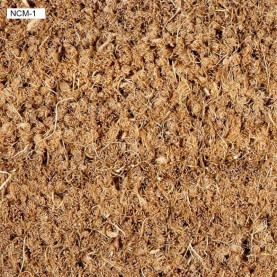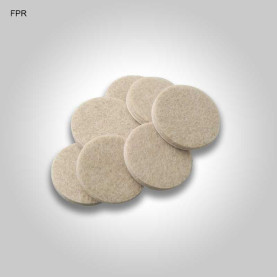Protecting Your Wooden Floor
#CraftedForLife
Felt pads are an essential part of your wood floor maintenance kit
First of all, to protect your wooden floor from scratches and damage, always lift and place furniture rather than dragging it. In addition felt pads should be applied to the feet of all furniture, and if the furniture has castors, castor cups should be used instead. Since felt pads can loosen over time, particularly on frequently moved items like chairs, it's important to check them regularly and replace them when needed. Before applying new pads, remove the old ones, clean off any adhesive residue, and ensure the surface is dry for a secure attachment.

Felt pads are essential for protecting your wooden floor.

Felt pads should be applied to the feet of all furniture including stools and pianos.

Castor cups are a useful alternative for sofa legs.

Castor cups here are used to protect the floor from the legs of a heavy dining table.
Even your felt pads need to be occasionally cleaned and replaced
Regular, light maintenance is key to success with your new wood floor. Felt pads should be occasionally cleaned by vacuuming, picking off debris, or wiping with a dry cloth. If the pads become wet, they should be dried immediately or replaced, as moisture can damage the floor. Over time, dirt and grit can embed in the felt, so replacing them periodically helps prevent scratches.

Felt pads need to be occasionally cleaned and replaced.

Felt pads should be occasionally cleaned by vacuuming.

Old pads can peel off and need to be replaced.

You may even want to add felt pads to your vacuum cleaner to protect your skirting boards and fixed furniture.
Be careful with moving deliveries around the house
Try to avoid dragging furniture or heavy objects across the floor, as even tiny debris like grit or small toys can cause damage. When receiving large deliveries, such as furniture, appliances, or pianos, always instruct the delivery team to lift and place items rather than dragging them. If needed, ask for assistance to ensure your floor remains in perfect condition.
Avoid using household cleaners
Don't use household dust cleaners or furniture polish on hardwood or highly polished floors, as this may cause your floor to become very slippery and dull the finish. Everyday clean cleaners will destroy the finishing coats of oil or lacquer. Food or other spills should be wiped immediately, using the manufacturers' recommended cleaner and a soft cloth.

Avoid using everyday household cleaners or furniture polish on your wooden floor.

Spills should be wiped immediately using a plain, soft cloth.
Doormats provide crucial protection for your floor
Doormats play a crucial role in protecting your wooden floor by trapping dirt, moisture, and debris before it gets inside. For maximum protection, it’s best to place a doormat inside the main entrance, by the garden door and by any side entrances. When placed on a wooden floor, an anti-slip mesh should be used underneath to keep it securely in place. If your floor was installed by us, we can retrofit a doormat frame to seamlessly integrate it into the design. Regular maintenance is essential—clean or wash the doormat frequently, and replace it every few years, depending on wear and usage.

We recommend integrated door mats as a neat way to protect your floor.

For maximum protection it’s best to place a doormat at all entrances.

We can retrofit a doormat frame to seamlessly integrate with your floor.

Replace your door mat every few years.
Ideally take off your outdoor shoes
To protect your wooden floor, opt for soft-soled shoes or slippers indoors rather than wearing outdoor footwear. Regularly check and clean the soles of your indoor shoes to prevent dirt and grit from being tracked in. High heels, particularly stilettos, can cause significant damage, as they exert up to 20 times more pressure per square inch than a flat shoe. To maintain the longevity of your floor, it is highly recommended to remove stiletto heels before walking on wooden surface.
Considerations with your pets
To help protect your wooden floor, keep your pets' claws well-trimmed and take dogs for regular walks to naturally wear them down. After outdoor walks, wipe and dry their paws to prevent dirt, grit, and moisture from being tracked inside. Dog saliva, especially from diets high in protein, fat, or citric acid, can be surprisingly acidic—wipe it away promptly to prevent damage.
Accidents will happen, particularly with puppies, kittens, and older pets. Any urine, excrement, vomit, or regurgitated hairballs should be cleaned up immediately, as they can be highly acidic and harmful to the floor’s finish. Use a wooden floor cleaner on affected areas for proper maintenance. In feeding areas, place a mat under food and water bowls to catch spills and crumbs. If using a rubber mat, choose a high-quality option without harsh chemicals that could damage the floor’s finish, and regularly clean underneath to prevent trapped moisture or dirt buildup.

Wipe away spills from pets promptly to prevent damage.

Keep your pets' claws well-trimmed to help protect your wooden floor.
Wipe away liquids quickly
To protect your wooden floor from liquid damage, always place wet shoes, scooters, bicycles, and buggies on rubber mats with raised edges to contain moisture. Any spilled liquid should be wiped up immediately, as prolonged exposure can cause damage. A small splash of clean water may not harm the floor, but leaks from washing machines, radiators, or pipes should be addressed immediately, and any standing water thoroughly dried.

Place buggies on rubber mats to help protect your floor.

Rubber mats with raised edges are ideal to help contain any moisture.
Be especially cautious with substances like cola, coffee, red wine, and bathroom cleaning products, as they can stain and deteriorate the finish if left too long. Wipe spills immediately and clean the affected area with a suitable wooden floor cleaner. Potted plants and Christmas tree stands can also be a hidden risk—water trapped beneath can cause long-term damage. Even waterproof saucers can create condensation, so it's best to place pots on trivets or stands to allow airflow underneath.

Potted plants and Christmas tree stands can be a hidden risk to your floor.

Place your plants in secure pots on trivets.
Rugs can be a welcome addition
Area rugs can be used to protect high-traffic pathways and key pivot areas such as landings, doorways, in front of sofas, and near kitchen sinks. They help minimise wear while adding warmth and comfort. However, avoid rubber-backed or non-ventilated rugs, as they can trap moisture and prevent the wood from naturally expanding and contracting. Opt for breathable materials that allow proper airflow to maintain the floor's longevity.
Daylight exposure causes the natural chemicals in wood to oxidise, leading to gradual colour changes in the floor. To maintain an even appearance, occasionally reposition area rugs and furniture to prevent uneven fading. Additionally, use curtains, blinds, or shades on large sun-facing windows to reduce direct sunlight and minimise variations in colour over time.

Don’t forget to occasionally wipe the wheels of your vacuum cleaner.

Built up dirt and grit can scratch your floor.
Read the related post on How to Clean Your Wooden Floors.





































